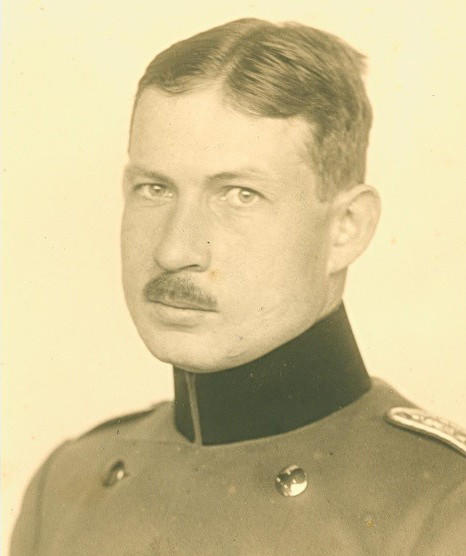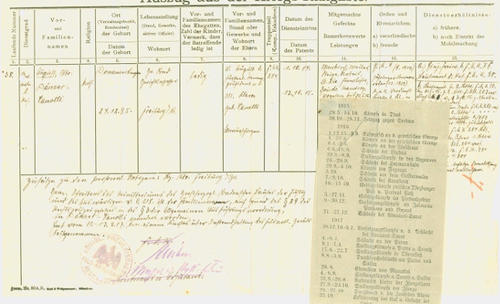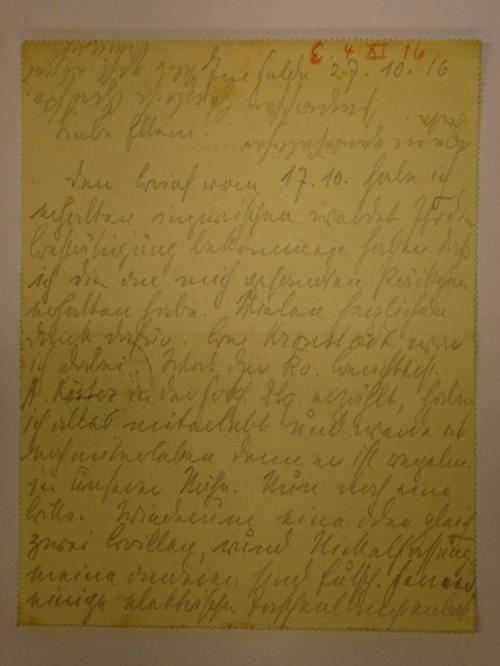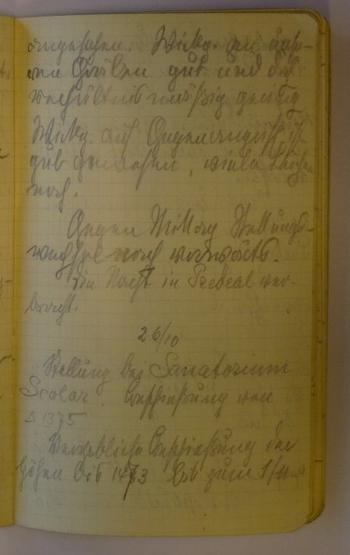The Letters and Diaries of Lieutenant-Colonel August Dänzer from his Time in Transylvania and Romania 1916/17
by Gundula Gahlen
“It is proceeding merrily down there and the Alps corps in particular has done some nice work.” - The letters and diaries of Lieutenant-Colonel August Dänzer from his time in Transylvania and Romania 1916/17
For a long time the proceedings in the west during the First World War received more attention from western historians than the seemingly more “conventional” war on the Eastern and Southeastern Fronts. Only over the last ten years, however, researchers have started to analyze these regions. Yet the research about southeastern Europe and the theaters of war in Serbia, Romania and Macedonia is still in its infancy. Additionally, as is the case with Romania, the letters and diaries of soldiers deployed to this region during the First World War have hardly been accessible to the general public.
Description of the Edition
The online edition of the field letters and diaries of German artillery Lieutenant-Colonel August Dänzer, who was active in combat in Transylvania and Romania, has been accessible since 2012. August Dänzer’s estate, located in the Stuttgart Library for Contemporary History (Bibliothek für Zeitgeschichte), is unique in that two different kinds of testimonials - letters and diaries - span the same time period and are passed on from an officer of a lower rank.
The online-edition includes a scan and transcription of every page from the diaries and letters. Furthermore, the printable version is also available for all entries and letters. The edition is then complemented by a short biography of August Dänzer, an outline of his military service in Transylvania and Romania, as well as by a publication of the guidelines of the transcription. Finally, rounding off the edition are contributions about the field letters as a source, the traffic of these letters in Transylvania and Romania, the interpretive patterns regarding the war within August Dänzer’s testimonials, and the potential insight to be gleaned from the comparative analysis of Dänzer’s letters and diaries.
The war against Romania
August Dänzers Kriegs - Rangliste
Image Credit: http://www.unicms. net/feldpostsammlung/index.php?art=43
During the military operation against Romania, August Dänzer was lieutenant of the reserve and leader of the 4th Battery in the 2nd department of the field artillery regiment 204 that was assigned to the Alpine Corps (Alpenkorps). This was a part of the 9th army that fought in Transylvania and northern Romania, while the Danube Army of the central powers was active in Dobruja and southern Romania.
The war against Romania was ignited in 1916 when the Ententes generous promise of territorial expansion, at the expense of Austria-Hungary, fine-tuned the heretofore-neutral Romania for war. On August 27, 1916 Romania declared war against Austria-Hungary and the Romanian army, without encountering much resistance, marched into Transylvania. Over the course of the following weeks, it was here that German and Austro-Hungarian units formed the 9th army under the command of General of the Infantry Erich von Falkenhayn.
Falkenhayn’s forces were able to drive the Romanian groups out of Transylvania in several stages. At the end of September 1916, August Dänzer took part in the battle of Sibiu and the combat around Fogaras. In October he participated in the battles by the Perşani Mountains and Brașov. This was then followed by combat in the Carpathian Mountains until the end of November 1916.
At the beginning of December, after the incursion into Wallachia and a reunion with the troops of the Danube army, the Romanian units were decisively beaten back at Battle of the Argeș and were consequently pushed back into Moldavia. The Alpine Corps followed the Romanian troops from Ialomita and Prahova to Buzau and partook in both the battle during the Christmas of 1916 at Râmnicu Sărat and in the battle of Putna at the beginning of January 1917. By mid-January, three-quarters of the Romanian territory up to the Siret line was occupied by the Central Powers. On this route and in the eastern Carpathians, the fighting changed into trench warfare. August Dänzer was active in the trench warfare at Putna and Siret until May 1917, before he was transported with the Alpine Corps to South Tyrol.
Characteristics of August Dänzer’s Testimonials
Letter from 10.27.1916
Image Credit: http://www.unicms. net/feldpostsammlung/index.php?ID_dokument=598&ID=302
While Dänzer took care to write almost daily in his war diary, the letters that are addressed to his parents in Freiburg (im Breisgau) are consistently written across greater time spans. The letters are significantly longer than the diary entries, which are often confined to several short bullet points. The letters, on the other hand, deliver a narrative structure and convey to the parents, as outside observers, what was experienced in an understandable form. They lend special attention to the contextual descriptions of everyday life in war and the procedures of battle but also to delineations of the landscape and its inhabitants. Yet a parallel reading of the letters and diaries clearly demonstrates that the constituting of experience in the letters is influenced by external factors like censorship or the parents’ expectations and experiential background while these are thoroughly missing in the diary’s entries.
Also noticeable in comparison with the letters, the diary entries are given the form of small notes and jottings. Dänzer probably wrote his diary primarily to help with his memory. The entries are written almost entirely in a sober style and contain many military abbreviations and technical terms. Accounts of experiences and sentiments are nevertheless to be found, albeit in a form not existent in the letters. And finally the daily diary serves as a continuous source, composed contemporaneous to the unfolding events, that enables the tracing of marching routes and August Dänzer’s everyday life in Transylvania and Romania and furthermore to contextualize these testimonials’ interpretations and perceptions.
Perception of Combat Operations
The descriptions of military life, tactical troop movements and combat occupy the most space in August Dänzer’s personal testimonials. The portrayals of military operations are primarily kept factual and objective, however many include evaluations, and mostly positive ones.
Despite the strains of the advancing winter, long marches and day-long ordnance shortages, August Dänzer, like most of the German military in the Romanian campaign, exhibited a high level of readiness for combat. In comparison to the anonymous, uncontrollable trench warfare of the West, he preferred the fighting in the southeast, a theater of war largely led as maneuver warfare that conceded the soldiers a large radius of action. Dänzer, who served from April to September 1916 on the Western Front and took part in the Verdun Offensive before relocating to Transylvania, spoke with relief to have left the western theater of war behind him.
What is striking is the lack of an enemy stereotype for the Romanians. Romania’s betrayal within the Triple Alliance was emphasized in the German press and the enemy’s image was central to this. However, Dänzer’s construction of meaning around the war included no such concept or stereotype. In his descriptions of the opponents, Dänzer clearly places less importance on their belonging to the enemy nation as on their general identity as soldiers. Accordingly Dänzer demonstrates sympathy, understanding and respect in regards to the adversarial soldiers.
The significant space that the descriptions of combat procedures occupy in the letters and diary entries, as well as the positive evaluations of them, attest to how Dänzer saw maneuver warfare operations primarily as tasks which were to be carried out with skill and precision. According to Dänzer’s perspective, this brought joy in addition to the danger and suspense. The extensive, calculated and tactical entries, the praising commentaries and the hunting metaphors that Dänzer applied to the mobile warfare in Transylvania and Romania speak to this. Additionally, the radius of action in maneuver warfare enabled recognition and honor in the form of medals - Dänzer writes exhaustively about this as he is rewarded with the iron cross 1st class.
Surely the thoroughly positive connotations of combat procedures also had something to do with the fact that the recipients of these letters were none other than Dänzer’s parents, whom he did not wish to frighten or depress. Naturally, then, the few passages in which the brutality of war comes through are found only in diary entries. Yet, even in these descriptions, the approving accounts of combat dominate.
August Dänzer is characterized first and foremost by his marked will to master the task given to him as artillery officer as best he can. This paramount driving force for his conduct manifests itself during the maneuver warfare at Siret from January to April of 1917, when Dänzer’s testimonials exhibit frustration for the first time in an explicit regression to the interpretive pattern of “perseverance”.
Perception of land and people
In addition to combat descriptions, portrayals of landscapes and people figure largely in August Dänzer’s letters, and, to a certain extent, also in his dairies. Dänzer’s personal testimonials show a thoroughly open, touristic view of Transylvania and Romania that avoided generalizations and that was not defined by the common images of the enemy circulated in the press. Still his observations were characterized by the conviction of German supremacy with respect to Romanian circumstances.
It becomes clear that the Romanian campaign opened a new world to August Dänzer, a world to which he previously had no mental or cultural connection to. With Romania’s entry into war, many German members of the military came, for the first time, into direct contact with this region. The conquerors encountered an agrarian population whose language, customs and practices were unknown to them. The troops reacted to these circumstances in their new operational field in accordance with their previous experience on the East and Southeastern Fronts or lack thereof: while some described the arrival as downright culture-shock, the others drew comparisons to the Russian Front and Serbia and often favored the new service area. August Dänzer belonged to this group; in addition to France and Tyrol, he had already been active in Serbia and Macedonia. Dänzer consistently assessed the Romanian circumstances in comparison to those in Serbia, whereby his comparisons repeatedly turn out to advantage Romania. In relation to the settlements of the Transylvanian Saxons, Dänzer primarily drew parallels to his Freiburg home.
August Dänzer fundamentally displays a feeling of cultural supremacy over the population in Romania. In this sense he represents an attitude that was just as common among the German public as well as among the younger officers and teams. This stance, however, was not a hate-infused ideology, but rather a conviction that the peoples were dissimilar from one another. Additionally this was not an attitude that was unique to the Germans, but rather detectable in all western nations at this time. The example of August Dänzer testifies that the feeling of being superior could be reconciled with genuine interest and nuanced observations.
Through their perceptual and interpretative patterns, August Dänzer’s letters and diaries represent some central experiences of German soldiers in Transylvania and Romania during the First World War. Specifically, Dänzer’s testimonials evince his pride about his practice of the art of warfare in the artillery as well as the distinct joy of getting to know new countries within the context of war.
Source
Gundula Gahlen (ed.), Feldpost 1916/16. Die Briefe und Tagebücher des Oberleutnants August Dänzer aus Siebenbürgen und Rumänien (2012), URL: http://www.uni-cms.net/feldpostsammlung.
Bibliography
-
Axel Bader, Der Rumänienfeldzug 1916. Der Kriegsalltag und seine Bewältigung durch die deutschen Soldaten, in: Österreich in Geschichte und Literatur 51 (2007), pp. 194-209.
-
Gundula Gahlen, Erfahrungshorizonte deutscher Soldaten im Rumänienfeldzug 1916/17, in: Bernhard Chiari, Gerhard Paul Groß, Magnus Pahl (eds.), Am Rande Europas? Der Balkan - Raum und Bevölkerung als Wirkungsfelder militärischer Gewalt, München 2009, pp. 137-158.
-
David D. Hamlin, ‘Wo sind wir?’ Orientalism, Gender and War in the German Encounter with Romania, in: German History 28 (2010), pp. 424-452.
-
Peter Kompiel, Das Erkenntnispotential einer vergleichenden Analyse der Briefe und Tagebücher August Dänzers, Seminararbeit am Fachbereich Geschichts- und Kulturwissenschaften der Freien Universität Berlin 2012, URL: http://www.uni-cms.net/feldpostsammlung/pdf/kompiel_vergleich.pdf.
-
Adrian Lehne, Darstellungs- und Deutungsmuster des Krieges in Siebenbürgen und Rumänien 1916/17 in den Briefen und Tagebucheinträgen August Dänzers, Seminararbeit am Fachbereich Geschichts- und Kulturwissenschaften der Freien Universität Berlin 2012, URL: http://www.uni-cms.net/feldpostsammlung/pdf/lehne_deutungsmuster.pdf.
-
Lisa Mayerhofer, Zwischen Freund und Feind – Deutsche Besatzung in Rumänien 1916-1918, München 2010.
-
Glenn E. Torrey, The Romanian battlefront in World War I, Kansas 2011.
Citation
Gahlen, Gundula: “It is proceeding merrily down there and the Alps corps in particular has done some nice work.” - The letters and diaries of Lieutenant-Colonel August Dänzer from his time in Transylvania and Romania 1916/17 (2015), URL: http://www.mwme.eu/essays/index.html
---
---
Translated by Westrey Page (Freie Universität Berlin)
---
Dr Gundula Gahlen (Freie Universität Berlin)
Dr Gahlen is a research associate at the Freie Universität in Berlin and currently works on 'Mentally Traumatized Officers of World War One in Germany'. From 2007 to 2011, within the scope of a DFG research project, she analyzed the experience of German soldiers in the Romanian Campaign.




